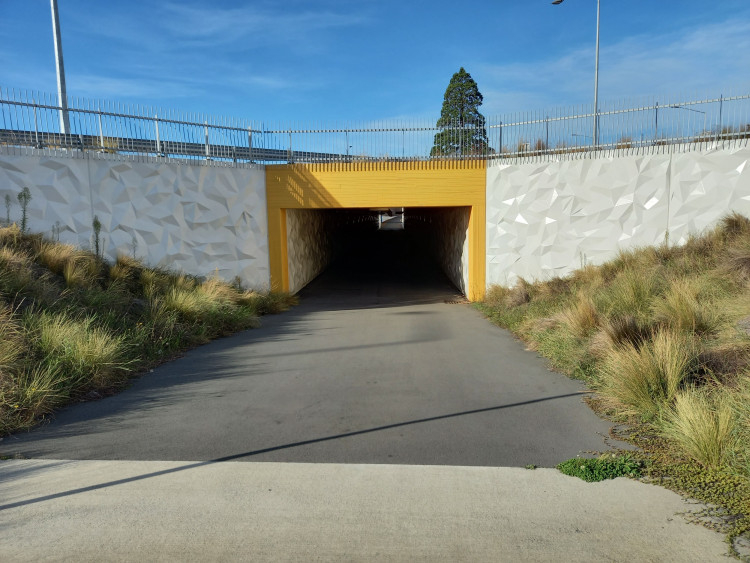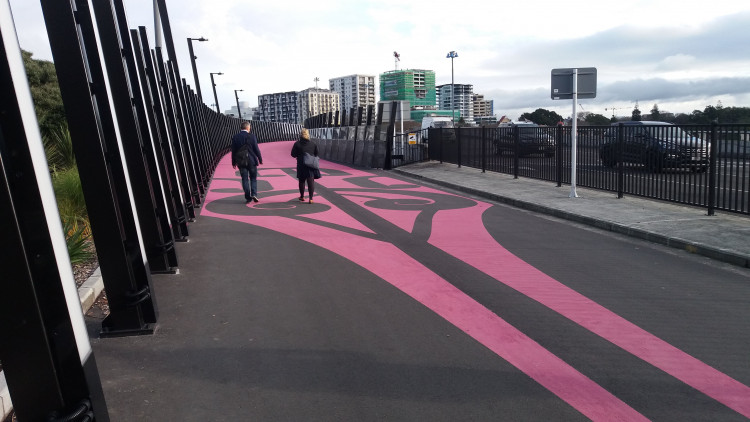Grade separation means infrastructure that puts pedestrians and other road users including rail at different heights. This typically includes pedestrian underpasses (tunnels and subways) and overpasses (footbridges and elevated walkways). This overcomes issues regarding greater travel distances for pedestrians using such facilities.
Grade separation can include under- and overpasses for motor vehicles with the pedestrian route remaining at-grade. Under and overpasses are often designed to accommodate cyclists as well as pedestrians.
An underpass and grade separated walkway are shown in the photos below.

Underpass under Harewood Road / Russley Road roundabout, Christchurch. (Photo: Jeanette Ward)

Use of a disused motorway ramp as a shared path, providing grade separated pathway. (Photo: Jeanette Ward)
Check whether grade separation is a suitable treatment for your site by referring to the following guidance:
PNG: Crossing selection process
A comparison of the advantages and disadvantages of overpasses and underpasses are outlined in the table below.
Table: Overpass and underpass considerations for pedestrians
|
Overpasses |
Underpasses |
|
|
A pedestrian or rider of a mobility device must use an underpass or a footbridge when one is reasonably available to the pedestrian for that purpose within a distance of 20m (Road User Rule, 11.3(1)).
Land Transport (Road User) Rule 2004
Grade separated crossings are most effective when they are more convenient for pedestrians than at-grade crossings. Pedestrians should ideally stay at the same grade when crossing or have only a minor change in level. The road could be elevated or sunk to reduce the amount of elevation change for pedestrians. In planning for new areas where a grade-separated crossing is required, it may be possible to utilise the terrain to achieve this. If this is not possible, ramps and steps that comply with standards are required.
Both over- and underpasses can result in longer walking journeys than at-grade crossings – and they are unlikely to be used where the walking distance is more than 50 percent greater than the at-grade distance. Even when less than this, some pedestrians will try to take the shortest route which may be across an unsafe location. Improving the convenience and aesthetics of the grade-separated option and potentially installing fencing may be necessary. Fencing should be continuous, unclimbable and long enough to prevent people walking around the ends.
Pedestrians can be concerned for their personal security at underpasses and overpasses, particularly if they are not well used.
PNG: Safety from other people in Pedestrian Network Characteristics
To overcome this:
Overpasses or underpasses may require the relocation of utilities. They can also provide a conduit for utilities.
Further guidance on the design of overpasses and underpasses for pedestrians can be found in the following:
Bridging the gap: NZTA Urban Design Guidelines
Many dimensions for overpasses and underpasses are determined by specific site conditions. The table below provides some general dimensions.
Table: Overpass and underpass design elements
| Feature |
Value |
Further information |
|
Width |
At least 2.4m |
It should be greater where the route is shared with other users (eg cyclists, scooters, etc). |
|
Overhead clearance |
Desired minimum 2.4m, absolute minimum 2.1m |
Greater clearance can help make the overpass/underpass feel more open. |
|
Grade change |
No more than 6.5m for overpasses |
There may be exceptions where constraints mean these grade changes need to be greater, eg. an overpass over electrified railway lines. |
|
Roadway clearance |
At least 4.9m (6.5m on overdimension routes) for overpasses only. |
See Overdimension route information in PNG: Requirements for other road users |
|
Approach ramps |
|
|
|
Access control devices |
Provide access control devices if necessary. |
|
|
Lighting |
Ensure lighting does not impact the overhead clearance. |
Appropriate emergency vehicle and maintenance vehicle access should also be provided.
[1] Corben, B. (2020). Integrating Safe System with Movement and Place for Vulnerable Road Users(external link), Austroads, AP-R611-20, p19